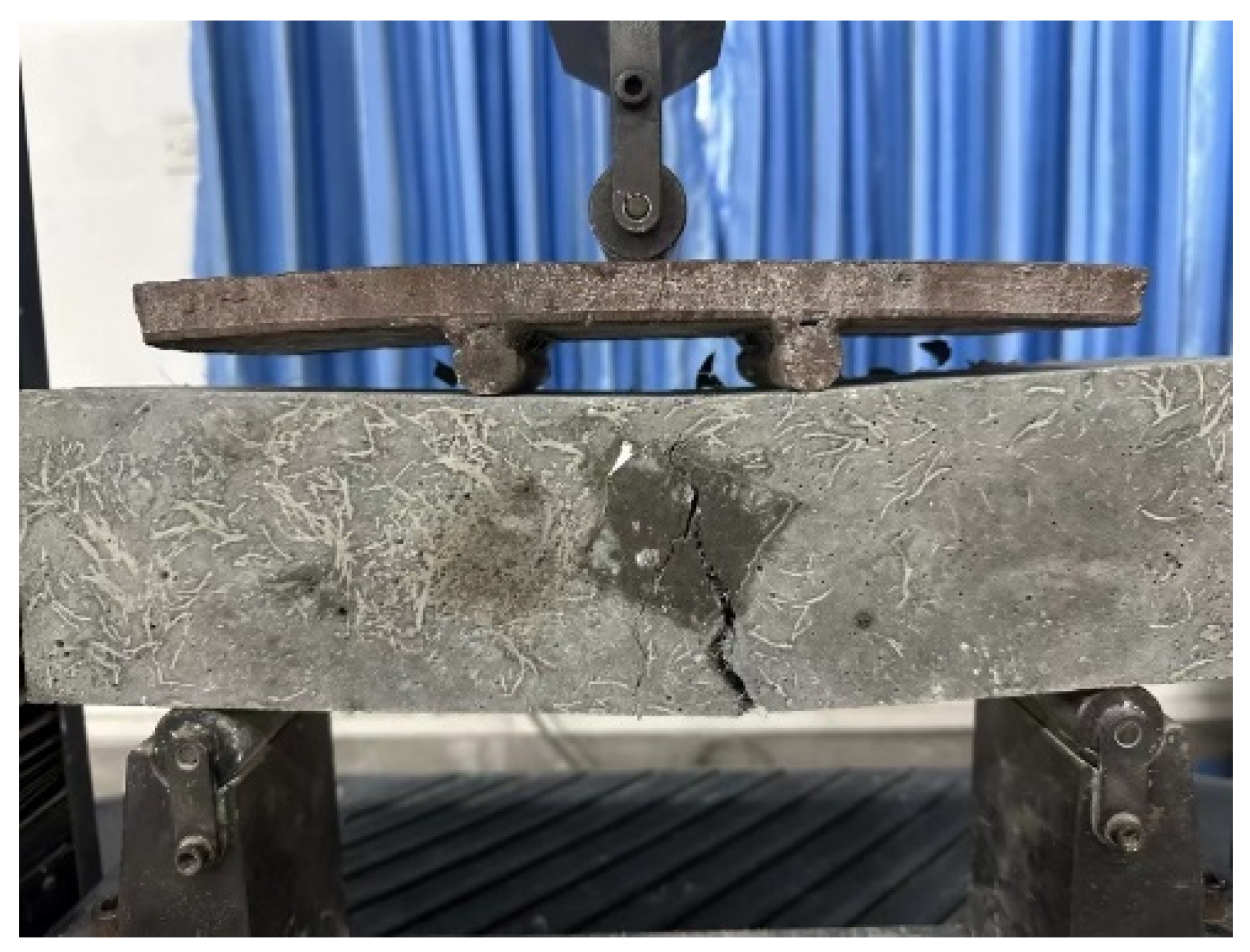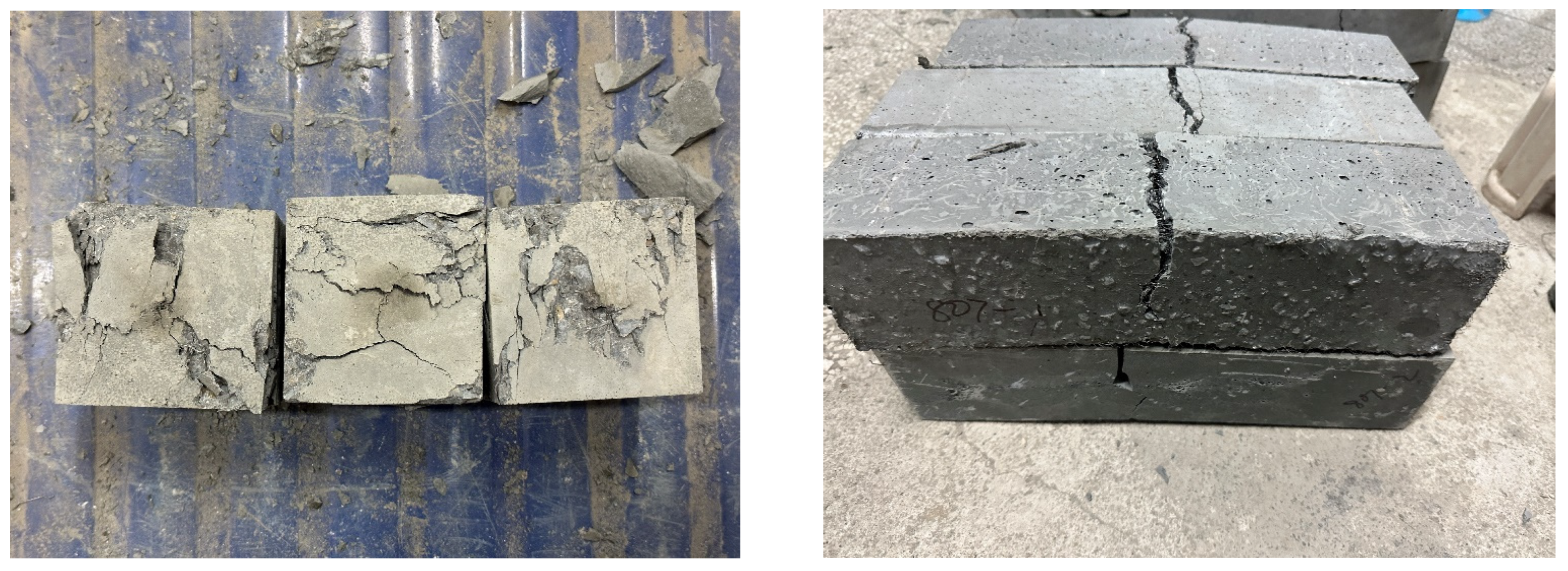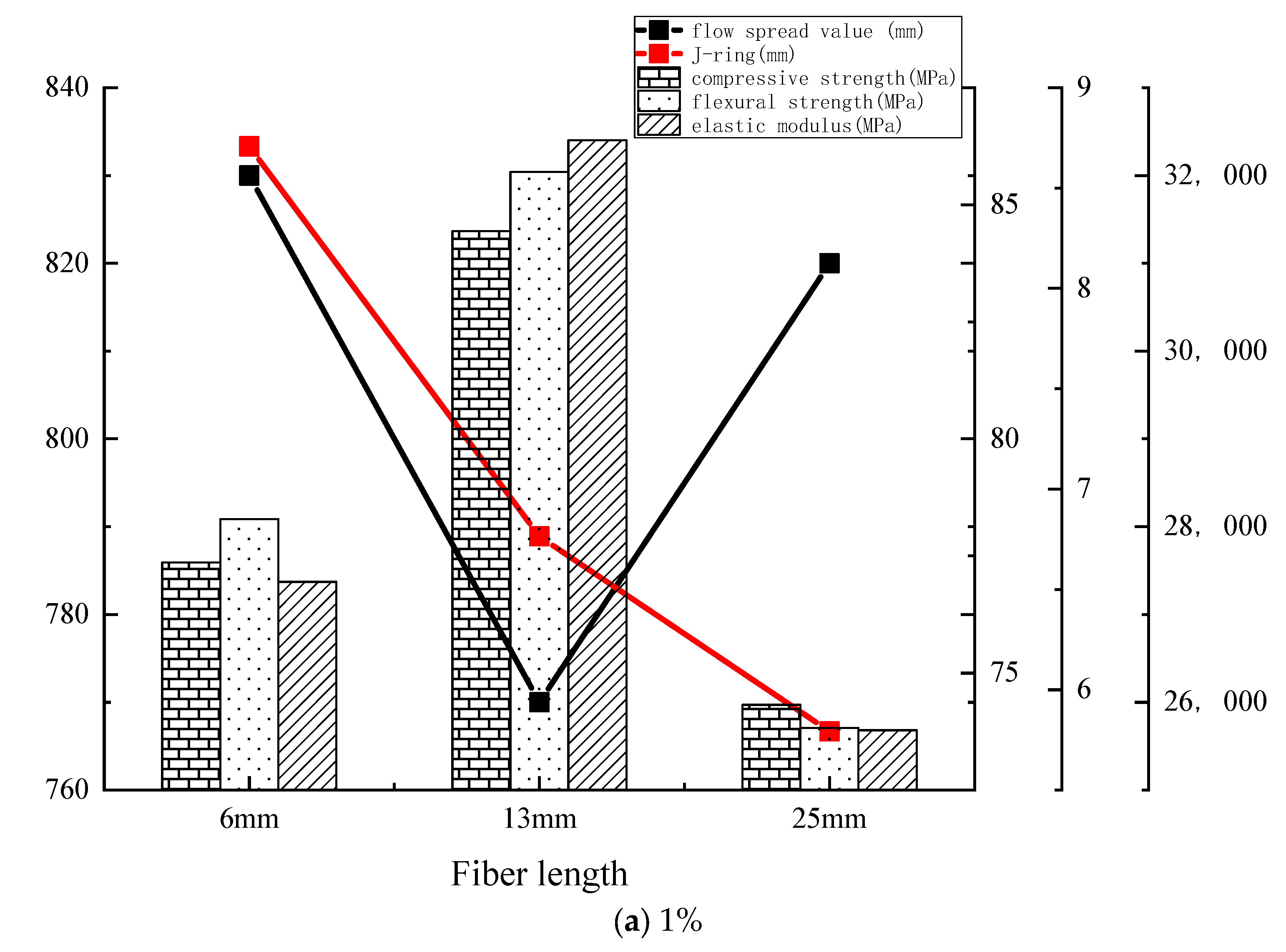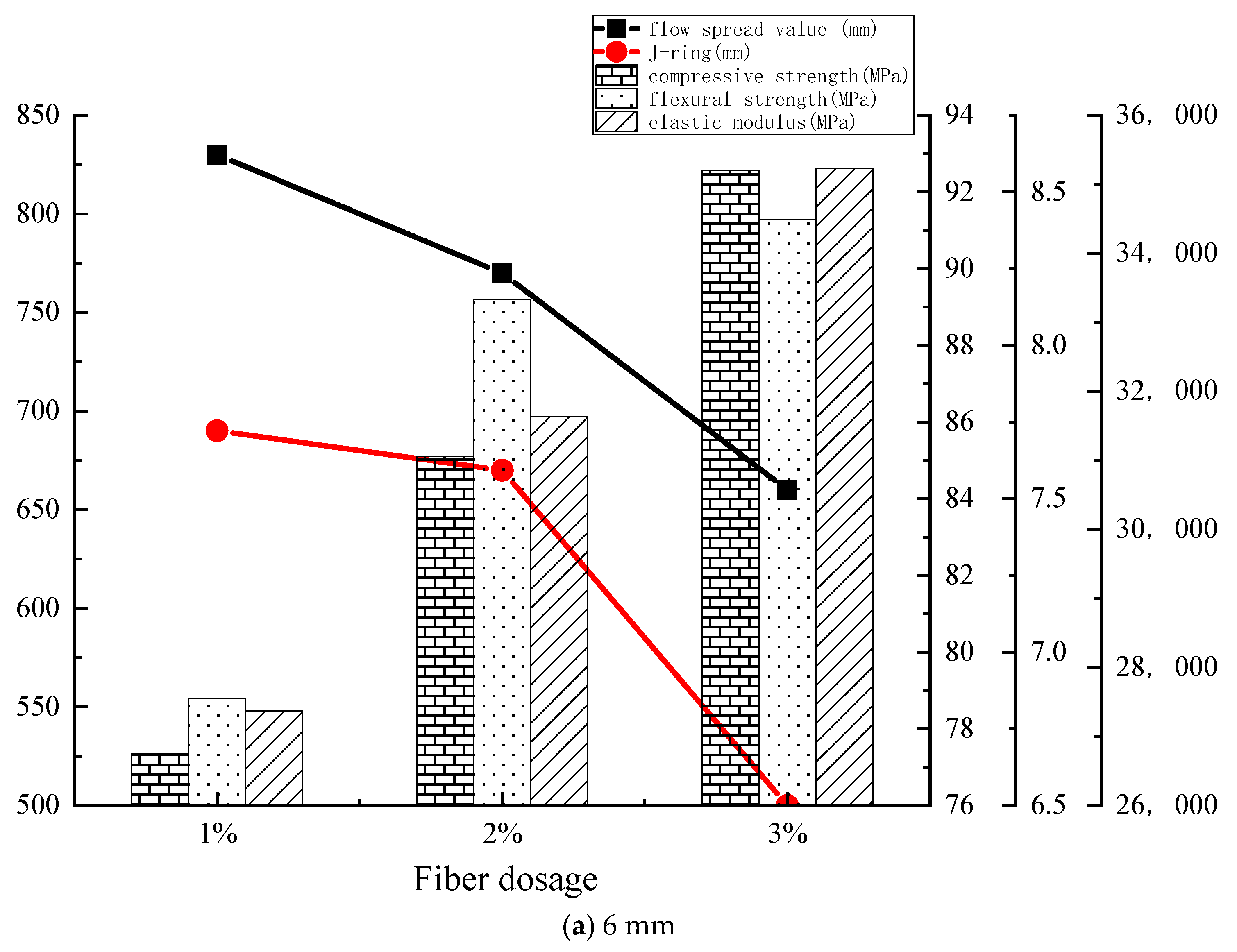Study on the Influence of Fiber Parameters on the Mechanical Properties of Self-Compacting Concrete
Abstract
1. Introduction
2. Materials and Methods
2.1. Raw Materials
2.2. Specimen Preparation
2.3. Experimental Preparation
2.4. Loading Methods
2.4.1. Cubic Compressive Strength Test
2.4.2. Flexural Strength Test
2.4.3. Modulus of Elasticity Test
3. Results and Analysis
3.1. Results of Workability Performance Tests
3.2. Influence of Fiber Length on the Mechanical Properties of Self-Compacting Concrete
3.3. Influence of Fiber Content on the Mechanical Properties of Self-Compacting Concrete
3.4. Tension–Compression Ratio
4. Mechanical Property Analysis of Fiber-Reinforced Self-Compacting Concrete
4.1. Solution of Positive and Negative Ideal Sequences of the TOPSIS Method Improved Using the Entropy Weight Method
- (1)
- Normalize the positive indicator values according to Equation (4) and the negative indicator values according to Equation (5) to obtain the standardized matrix B = (m × n).
- (2)
- Calculate the proportion of the i—the sample index value under the j—the index according to Equation (6) to obtain the matrix F = (m × n).
- (3)
- The entropy weight method is adopted to calculate the index weights. Calculate the information entropy value according to Equation (7). The larger the information entropy value is, the greater the information entropy of the j—the index is. Calculate the weights according to Equation (8). The larger the index coefficient calculated by the entropy value method is, the greater the weight is, and the greater the contribution to the result is.
- (4)
- Apply the weights obtained using the entropy weight method to the solution of the positive and negative ideal sequences in the TOPSIS method. Construct the normalized decision making matrix , as shown in Equation (9), based on the index weights. Determine the optimal scheme and the worst scheme according to Equation (10) and Equation (11), respectively. Calculate the distance from the positive ideal solution and the distance from the negative ideal solution according to Equation (12) and Equation (13), respectively. Finally, calculate the score of the i-th group of tests according to Equation (14).
4.2. Analysis of the Mechanical Properties of Fiber-Reinforced Self-Compacting Concrete Based on Gray Relational Analysis
5. Discussion
6. Conclusions
- (1)
- With the increase in the steel fiber volume fraction, the compressive and flexural strengths of SFRSCC are significantly enhanced. When the volume fraction reaches 3%, the compressive and flexural strengths increase by 25.7% and 280%, respectively, compared to the reference group. However, the elastic modulus peaks at a volume fraction of 2%, and further increasing the fraction to 3% leads to uneven fiber dispersion, resulting in a slowdown in performance improvement.
- (2)
- Steel fibers with different aspect ratios exhibit varying enhancement effects on the mechanical properties of SCC. Short fibers (6 mm) demonstrate optimal compressive strength at a 3% volume fraction; medium-length fibers (13 mm) significantly improve flexural strength; and long fibers (25 mm) achieve the highest elastic modulus at a 2% volume fraction.
- (3)
- By employing an improved entropy-weighted TOPSIS method and gray relational analysis, this study constructs a multi-criteria comprehensive evaluation model, revealing the nonlinear correlation patterns between fiber parameters and mechanical properties. The results indicate that a combination of a high volume fraction (3%) and medium-length fibers (13 mm) achieves a balance between flexural strength and toughness, providing a theoretical basis for the engineering application of high-toughness SFRSCC.
Author Contributions
Funding
Data Availability Statement
Conflicts of Interest
References
- Ashish, D.K.; Verma, S.K. An overview on mixture design of self-compacting concrete. Struct. Concr. 2019, 20, 371–395. [Google Scholar] [CrossRef]
- Wang, E.; Li, G.; Chai, Y.; Zhang, H.; Li, Y.; Wang, Y. Fracture performance of steel-sisal hybrid fiber recycled aggregate concrete. Bull. Chin. Ceram. Soc. 2023, 42, 2754–2763. [Google Scholar]
- Revilla-Cuesta, V.; Skaf, M.; Faleschini, F.; Manso, J.M.; Ortega-López, V. Self-compacting concrete manufactured with recycled concrete aggregate: An overview. J. Clean. Prod. 2020, 262, 121362. [Google Scholar] [CrossRef]
- Lv, Y.; Yang, Y. Experimental study on freeze-thaw performance of hybrid fiber reinforced self-compacting concrete. China Concr. Cem. Prod. 2020, 11, 52–56. (In Chinese) [Google Scholar]
- Kathirvel, P.; Murali, G.; Vatin, N.I.; Abid, S.R. Experimental study on self-compacting fibrous concrete comprising magnesium sulphate solution treated recyeled aggregates. Materials 2022, 15, 340. [Google Scholar] [CrossRef] [PubMed]
- Lu, X.; Zhang, Y.; Nian, X. Experimental study on stress-strain curves for high-strength steel fiber reinforced concrete under monotonic and repeated compressive loadings. J. Build. Struct. 2017, 38, 135–143. [Google Scholar]
- Xu, L.; Li, B.; Chi, Y.; Huang, B. Experimental investigation on stress-strain relation of steel-polypropylene hybrid fiber reinforced concrete subjected to uniaxial cyclic compression. J. Build. Struct. 2018, 39, 140–152. [Google Scholar]
- Wang, L.; Yang, Y.; Chen, J.; Li, J.W. Research on the proportion of self-compacting early-strength concrete with basafiber. Highway 2020, 65, 256–259. (In Chinese) [Google Scholar]
- Chen, J.; Zhuang, J.; Shen, S.; Dong, S. Experimental investigation on the impact resistance of rubber self-compacting concrete. Structure 2022, 39, 691–704. [Google Scholar] [CrossRef]
- Wang, J.Q.; Dai, Q.L.; Si, R.Z. Experimental and numerical investigation of fracture behaviors of steel fiber-reinforced rubber self-compacting concrete. J. Mater. Civ. Eng. 2021, 34, 04021379. [Google Scholar] [CrossRef]
- Chen, Q.; Xu, L.; Wu, F.; Zeng, Y.; Liang, X. Experimental investigation on strength of steel-polypropylene hybrid fiber reinforced ultra high performance concrete. Bull. Chin. Ceram. Soc. 2020, 39, 740–748+755. [Google Scholar]
- Luo, S.R.; Zheng, J.L.; Wang, G.J. Study and Application of Mechanical Properties of Self-Compacting High-Performance Concrete. Eng. Mech. 2005, 22, 164–169. (In Chinese) [Google Scholar]
- Zhao, G.F. Development and Application of Concrete and Its Reinforcement Materials. J. Build. Mater. 2000, 3, 1–6. (In Chinese) [Google Scholar]
- Cao, Q.; Cheng, Y.L.; Wang, X.F. A Review of Fiber-Reinforced Self-Compacting Concrete. Concrete 2016, 1, 123–126. (In Chinese) [Google Scholar]
- Song, P.S.; Huang, S. Mechanical properties of high-strength steel fiber-reinforced concrete. Constr. Build. 2004, 18, 669–673. [Google Scholar] [CrossRef]
- Pereira, E.N.B.; Barros, J.A.O.; Camoes, A. Steel fiber rein forced self-compacting concrete: Experimental research and numerical simulation. J. Struct. Eng. 2008, 134, 1310–1321. [Google Scholar] [CrossRef]
- Zhang, X.Y.; Cao, C.J.; Sun, L.; Huo, H.Y. Experimental Study on Axial Compressive Stress-Strain Curve of Steel Fiber-Reinforced Concrete. Concrete 2013, 5, 24–27. [Google Scholar]
- Siddique, R.; Kaur, G. Strength and permeation properties of self-compacting concrete containing fly ash and hooked steel fibres. Constr. Build. Mater. 2016, 103, 15–22. [Google Scholar] [CrossRef]
- Palacio, A.J.; Raggiotti, B.B.; Rougier, V.C. Development and experimental verification of a design method for steel fibre-reinforced high strength lightweight self-compacting concrete. Constr. Build. Mater. 2024, 453, 139012. [Google Scholar] [CrossRef]
- Iqbal, S.; Ali, A.; Holschemacher, K.; Bier, T.A. Effect of change in micro steel fiber content on properties of high strength steel fiber reinforced lightweight self-compacting concrete (HSLSCC). Procedia Eng. 2015, 122, 88–94. [Google Scholar] [CrossRef]
- Athiyamaan, V.G. Mohan Ganesh1. Analysis of the Alignment of Micro-Steel Fibers in Admixture-Based Self-Compacting Concrete (MSFR-SCC) using NDT and Evaluation of Its Effect on the Modulus of Rupture. Int. J. Technol. 2019, 10, 5–15. [Google Scholar] [CrossRef]
- Aghaee, K.; Yazdi, M.A.; Tsavdaridis, K.D. Investigation into the mechanical properties of structural lightweight concrete reinforced with waste steel wires. Mag. Concr. Res. 2015, 67, 197–205. [Google Scholar] [CrossRef]
- Ou, Y.C.; Tsai, M.S.; Liu, K.Y.; Chang, K.C. Compressive behavior of steel fiber-reinforced concrete with a high reinforcing index. J. Mater. Civ. Eng. 2012, 24, 207–215. [Google Scholar] [CrossRef]
- Gordon, B.; Birkimer, D.; Mckee, D. Sate of the ant report on fiber reinforced concrete. Farmington Hills Mich. ACI Commite 1973, 544, 536. [Google Scholar]
- Khaloo, A.; Raisi, E.M.; Hosseini, P.; Tahsiri, H. Mechanical performance of self-compacting concrete reinforced with steel fibers. Constr. Build. Mater. 2014, 51, 179–186. [Google Scholar] [CrossRef]
- Nis, A. Mechanical properties of steel fiber reinforced self-compacting concrete. Int. J. Eng. Technol. 2018, 4, 33–40. [Google Scholar] [CrossRef]
- Hai, R.; Liu, P.; Yang, Y.M.; Liu, J. Mechanical properties of steel fiber reinforced fly ash self-compacting concrete. J. Build. Mater. 2021, 24, 87–92. (In Chinese) [Google Scholar]
- Saba, A.M.; Khan, A.H.; Akhtar, M.N.; Khan, N.A.; Koloor, S.S.R.; Petrů, M.; Radwan, N. Strength and flexural behavior of steel fiber and silica fume incorporated self-compacting concrete. J. Mater. Res. Technol. 2021, 12, 1380–1390. [Google Scholar] [CrossRef]
- Zhou, J.Y. Experimental Study and Numerical Simulation of the Properties of Fiber Self-Compacting Concrete. Master’s Thesis, Tianjin University, Tianjin, China, 2018. (In Chinese). [Google Scholar]
- da Silva, G.C.; Christ, R.; Pacheco, F.; de Souza, C.F.; Gil, A.M.; Tutikian, B.F. Evaluating steel fiber-reinforced self-consolidating concrete performance. Struct. Concr. 2020, 21, 448–457. [Google Scholar] [CrossRef]
- Jen, G.; Trono, W.; Ostertag, C.P. Self-consolidating hybrid fiber reinforced concrete: Development, properties and composite behavior. Constr. Build. Mater. 2016, 104, 63–71. [Google Scholar] [CrossRef]
- Pajak, M. Investigation on flexural properties of hybrid fibre reinforced self-compacting concrete. Procedia Eng. 2016, 161, 121–126. [Google Scholar] [CrossRef]
- Zhang, H. Early capability and damage analysis of self-compacting, steel-fiber-reinforced lightweight aggregate concrete. Mater. Rep. 2017, 31, 124–128. [Google Scholar]
- Tao, H. Study on Physical and Mechanical Properties of Steel Fiber High Strength Self-Compacting Concrete. Master’s Thesis, Zhongyuan University of Technology, Zhengzhou, China, 2022. [Google Scholar]
- Farhan, N.A.; Sheikh, M.N.; Hadi, M.N. Effect of Steel Fiber on Engineering Properties of Geopolymer Concrete. ACI Mater. J. 2020, 117, 29–40. [Google Scholar]
- Al Rifai, M.M.; Sikora, K.S.; Hadi, M.N. Effect of micro steel fibers volume fraction on behavior of high-strength self-compacting concrete. Constr. Build. Mater. 2024, 450, 138709. [Google Scholar] [CrossRef]
- JGJ/T 283-2012; Technical Specification for Application of Self-Compacting Concrete. China Architecture & Building Press: Beijing, China, 2012.
- JGJ 55-2011; Standard for Mix Proportion Design of Ordinary Concrete. China Architecture & Building Press: Beijing, China, 2011.
- Karuppasamy, M.; Balakrishnan, B.; Chandran, K.; Gheisari, M.; Rezaeiye, P.P.; Andrievsky, B. Analysis of mechanical properties in self-compacting concrete enhanced with steel fibres. Micro Nano Lett. 2024, 19, e12203. [Google Scholar] [CrossRef]
- Ghorbani, S.; Sharif, S.; Rokhsarpour, H.; Shoja, S.; Gholizadeh, M.; Rahmatabad, M.A.D.; de Brito, J. Effect of magnetized mixing water on the fresh and hardened state properties of steel fibre reinforced self-compacting concrete. Constr. Build. Mater. 2020, 248, 118660. [Google Scholar] [CrossRef]










| Serial Number | Cement (kg) | Water (kg) | Fly Ash (kg) | Coarse Aggregate (kg) | Fine Aggregate (kg) | Water Reducing Agent (%) | Steel Fiber Dosage (%) |
|---|---|---|---|---|---|---|---|
| 1 | 1 | 0.37 | 0.43 | 1.37 | 1.06 | 0.16% | 0 |
| 2 | 1 | 0.37 | 0.43 | 1.37 | 1.06 | 0.16% | 1% 6 mm |
| 3 | 1 | 0.37 | 0.43 | 1.37 | 1.06 | 0.16% | 2% 6 mm |
| 4 | 1 | 0.37 | 0.43 | 1.37 | 1.06 | 0.16% | 3% 6 mm |
| 5 | 1 | 0.37 | 0.43 | 1.37 | 1.06 | 0.16% | 1% 13 mm |
| 6 | 1 | 0.37 | 0.43 | 1.37 | 1.06 | 0.16% | 2% 13 mm |
| 7 | 1 | 0.37 | 0.43 | 1.37 | 1.06 | 0.16% | 3% 13 mm |
| 8 | 1 | 0.37 | 0.43 | 1.37 | 1.06 | 0.16% | 1% 25 mm |
| 9 | 1 | 0.37 | 0.43 | 1.37 | 1.06 | 0.16% | 2% 25 mm |
| 10 | 1 | 0.37 | 0.43 | 1.37 | 1.06 | 0.16% | 3% 25 mm |
| Test Content | Specimen Size (mm) | Number of Specimens (pcs) | Sample Size (Number) |
|---|---|---|---|
| Compressive strength | 100 × 100 × 100 | 6 | 60 |
| Flexural strength | 100 × 100 × 400 | 6 | 60 |
| Flexural and tensile modulus of elasticity | 100 × 100 × 400 | 6 | 60 |
| Number | Fiber Length | Fiber Content | Slump Flow Diameter (mm) | J-Ring Slump Flow Diameter (mm) |
|---|---|---|---|---|
| S-0 | 0 | 0 | 840 | 800 |
| 1% 6 | 6 mm | 1% | 830 | 690 |
| 2% 6 | 6 mm | 2% | 770 | 670 |
| 3% 6 | 6 mm | 3% | 660 | 500 |
| 1% 13 | 13 mm | 1% | 770 | 670 |
| 2% 13 | 13 mm | 2% | 730 | 640 |
| 3% 13 | 13 mm | 3% | 560 | 410 |
| 1% 25 | 25 mm | 1% | 820 | 660 |
| 2% 25 | 25 mm | 2% | 760 | 610 |
| 3% 25 | 25 mm | 3% | 730 | 530 |
| Number | Score | Rank |
|---|---|---|
| 1% 6 | 0.290462 | 8 |
| 2% 6 | 0.330739 | 7 |
| 3% 6 | 0.352705 | 5 |
| 1% 13 | 0.3477 | 6 |
| 2% 13 | 0.467996 | 2 |
| 3% 13 | 0.479393 | 1 |
| 1% 25 | 0.214639 | 3 |
| 2% 25 | 0.377609 | 4 |
| 3% 25 | 0.439457 | 9 |
| Fiber Characteristic Parameters | Correlation Degree | ||
|---|---|---|---|
| Compressive Strength | Flexural Strength | Elastic Modulus | |
| Length | 0.6218 | 0.6873 | 0.6457 |
| Dosage | 0.6532 | 0.7056 | 0.6781 |
Disclaimer/Publisher’s Note: The statements, opinions and data contained in all publications are solely those of the individual author(s) and contributor(s) and not of MDPI and/or the editor(s). MDPI and/or the editor(s) disclaim responsibility for any injury to people or property resulting from any ideas, methods, instructions or products referred to in the content. |
© 2025 by the authors. Licensee MDPI, Basel, Switzerland. This article is an open access article distributed under the terms and conditions of the Creative Commons Attribution (CC BY) license (https://creativecommons.org/licenses/by/4.0/).
Share and Cite
Zhao, Y.; Ru, N.; Wang, J.; Li, Y.; Zhou, Y. Study on the Influence of Fiber Parameters on the Mechanical Properties of Self-Compacting Concrete. Constr. Mater. 2025, 5, 25. https://doi.org/10.3390/constrmater5020025
Zhao Y, Ru N, Wang J, Li Y, Zhou Y. Study on the Influence of Fiber Parameters on the Mechanical Properties of Self-Compacting Concrete. Construction Materials. 2025; 5(2):25. https://doi.org/10.3390/constrmater5020025
Chicago/Turabian StyleZhao, Yu, Nan Ru, Jun Wang, Yong Li, and Yi Zhou. 2025. "Study on the Influence of Fiber Parameters on the Mechanical Properties of Self-Compacting Concrete" Construction Materials 5, no. 2: 25. https://doi.org/10.3390/constrmater5020025
APA StyleZhao, Y., Ru, N., Wang, J., Li, Y., & Zhou, Y. (2025). Study on the Influence of Fiber Parameters on the Mechanical Properties of Self-Compacting Concrete. Construction Materials, 5(2), 25. https://doi.org/10.3390/constrmater5020025




